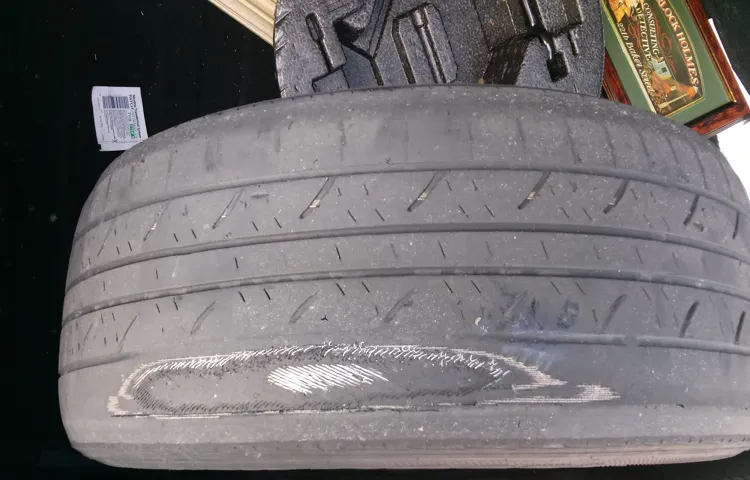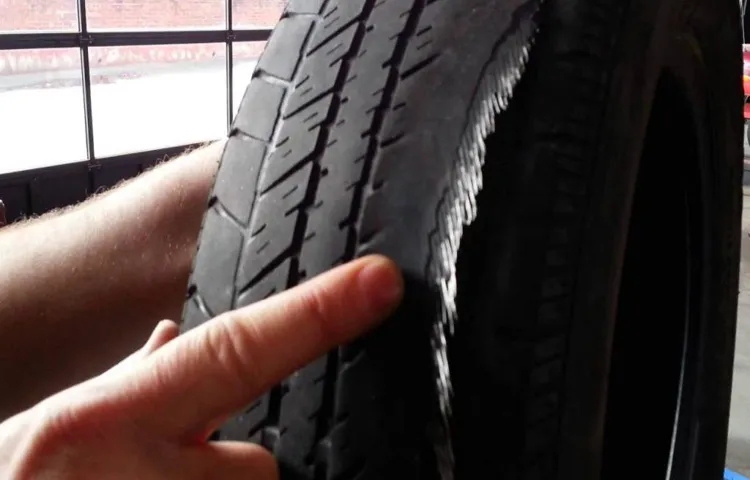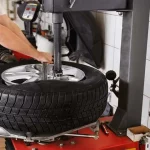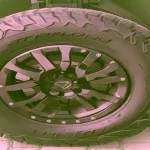Have you ever gone for a ride on your bike, only to notice that your back tire feels unusually warm? It can be quite disconcerting, and you may start to wonder if there’s an underlying issue. First, take a deep breath and don’t panic. There are a few reasons why your back tire may be heating up, and most of them are quite easy to fix.
In this blog post, we’ll explore the possible causes of a hot back tire, and what you can do to keep your ride safe and comfortable. So, buckle up, and let’s hit the road together!
Table of Contents
Potential Causes
If you notice that your back tire is hot after a ride, there could be several potential causes. One reason could be that your tire pressure is too low, causing excessive friction and heat buildup. Another reason could be that your brakes are dragging, causing constant friction on the tire and rim.
Additionally, worn wheel bearings or a misaligned wheel could also cause excess heat on your back tire. It’s important to address these issues promptly to ensure your safety on the road and prevent any further damage to your bike. Consider having a professional mechanic inspect your bike to identify and fix the issue before it becomes a bigger problem.
Always remember to check your tire pressure and brake pads regularly to prevent any unexpected incidents on your ride.
1. Overinflated Tire
An overinflated tire can be a potential cause of many problems you may face during your driving experience. One of the reasons you may have overinflated tires is the incorrect adjustment of the air pump. If the air nozzle is not adjusted perfectly, the pressure may go beyond the required level, leading to overinflation.
Additionally, exposure to the sun or heat for an extended period can cause the tire to overinflate. As a result, the pressure of the air inside the tire increases, which may lead to a risk of blowout. It’s essential to check your tire’s pressure regularly and maintain the required levels, even when the car is not in use, as weather changes can impact tire pressure.
Always be prepared, don’t take the risk of overinflating your tires. It may save you time and money, and most importantly, keep you safe on the road.

2. Underinflated Tire
One of the potential causes for an underinflated tire is simply forgetting to check your tire pressure regularly. It’s easy to forget about your tires, but it’s important to remember them as they play a critical role in keeping you safe on the road. Another cause of underinflation is a slow leak, which can be caused by a puncture or damaged valve stem.
When a tire is underinflated, it creates excess heat as it flexes under the weight of the vehicle. This can cause the tread to separate from the tire, leading to a blowout. Additionally, an underinflated tire can reduce fuel efficiency and increase tire wear and tear, leading to further problems down the road.
To avoid these issues, it’s important to regularly check your tire pressure and make sure your tires are properly inflated to the manufacturer’s recommended pressure. This simple step can help ensure the safety and longevity of your tires, and ultimately, your vehicle.
3. Worn Brake Pads
When it comes to worn brake pads, there are a few potential causes to consider. One common cause is simply driving your vehicle for an extended period without replacing the brakes. Over time, the friction between the brake pads and rotors will wear down the pads, causing them to become less effective at stopping your car.
Another cause may be aggressive driving, such as rapid braking or constantly stopping at high speeds. This can put extra stress on your brakes and cause them to wear down faster than normal. Additionally, if your brake pads are not installed correctly or if there are other underlying issues with your braking system, this can also lead to worn out brake pads.
It’s important to address any issues with your brakes as soon as possible to ensure that they are functioning safely and effectively. If you notice any issues with your brakes, such as squeaking or grinding noises, reduced stopping power, or a shaking or vibrating sensation when braking, it’s best to have them inspected by a professional. By addressing any issues early on, you can help prevent more serious problems down the road and keep yourself and your passengers safe on the road.
4. Bearing Issues
When it comes to bearing issues, there are several potential causes that you need to consider. One of the most common causes is improper lubrication. Adequate lubrication is crucial to ensuring that the bearing operates smoothly without any unnecessary friction that can lead to wear and tear.
Other potential causes include contamination from dirt or debris that can cause damage to the bearing, as well as improper alignment that can cause uneven pressure on the bearing. Additionally, overloading or excessive vibration can also contribute to bearing issues. To prevent these potential causes from turning into major bearing problems, it’s important to perform regular maintenance checks, such as cleaning the bearings and ensuring proper lubrication.
By taking these preventative measures, you can help to extend the lifespan of your bearings and prevent costly and time-consuming repairs.
5. Stuck Brake Caliper
If you’re experiencing a stuck brake caliper, there could be several potential causes. One possible reason is that your caliper piston is corroded or damaged, which may prevent it from moving as it should. Another possibility is that the caliper slides are obstructed or worn out, preventing the caliper from functioning correctly.
A third cause could be a faulty brake hose or line, leading to inadequate pressure in the brake system. Additionally, a contaminated brake fluid or lack of lubrication in the caliper slides can also cause a stuck brake caliper. The good news is that all of these issues can typically be resolved relatively easily by a trained technician, who will assess the situation and recommend the proper repair.
Don’t ignore a stuck brake caliper, as it can compromise your safety on the road and result in additional damage to your vehicle!
What to Do
Have you noticed that your back tire is unusually hot? This can be caused by a number of factors, but the most common one is over-inflation. When your tire is over-inflated, it can create excess heat due to increased pressure. Another reason could be that your brakes are sticking or dragging, causing friction and heat buildup.
It’s essential to check your tire pressure regularly and ensure that it’s at the manufacturer-recommended level. Also, make sure that your brakes are in good condition and not dragging. If you notice any unusual noises or vibrations while driving, take your vehicle to a professional for a thorough inspection.
Ignoring these warning signs can lead to costly repairs or even accidents. Remember, your safety is the top priority, so always keep your tires and brakes in good condition to avoid any mishaps.
1. Check Tire Pressure
Keeping your tires properly inflated is one of the simplest yet most impactful things you can do for your vehicle’s safety and performance. Checking your tire pressure regularly is a crucial aspect of tire maintenance. Low tire pressure can cause a host of problems such as reduced fuel economy, tire wear, and even blowouts or accidents.
The ideal tire pressure for your vehicle can be found in your owner’s manual or on a sticker located on the driver’s side door jam. To check your tire pressure, you will need a tire gauge and a source of air, such as a gas station air pump or an air compressor. Simply remove the valve cap, press the gauge onto the valve stem and read the pressure.
If the pressure is below the recommended level, add air until you reach the correct pressure. Remember to check all four tires, including the spare, and to check them when the tires are cold, as air pressure can increase with heat. By regularly checking your tire pressure, you can help ensure your vehicle’s safety, longevity, and performance.
2. Inspect Brake Pads
When it comes to inspecting brake pads, it’s important to know what to look for and what to do if you find any issues. Firstly, you should look for any signs of wear and tear, as well as any unusual noises or vibrations coming from your brakes. If you notice anything unusual, it’s best to take your car to a mechanic for a full inspection.
However, if you do spot some wear on your brake pads, it may be time to replace them. Replacing brake pads is a relatively simple process, but it’s important to make sure you use high-quality replacements to ensure your safety on the road. Additionally, it’s important to properly break in new brake pads to ensure they work effectively and don’t cause any problems down the line.
Ultimately, keeping your brake pads in good condition is critical for your safety and the safety of those around you. So, make sure to inspect them regularly and take action if necessary.
3. Check Bearings
When it comes to keeping your equipment in top condition, checking the bearings is a crucial step. Bearings are what allow parts of the machine to rotate smoothly, and if they aren’t in good shape, it can lead to serious problems. The first thing you should do is visually inspect the bearings to see if there are any signs of damage like cracks or discoloration.
If everything looks good, you can move on to checking the lubrication. Bearings need adequate lubrication to work properly, so make sure they are well greased or oiled. If the bearings are dry, it’s important to add lubrication right away to prevent them from wearing out too quickly.
If you notice any problems with the bearings during your inspection, it’s best to replace them as soon as possible to avoid more serious damage to your machine. By taking the time to check your bearings regularly, you can ensure that your equipment runs smoothly and stays in good working order for years to come.
4. Inspect Brake Caliper
When inspecting your brake caliper, the first thing you want to do is have a good understanding of what it is and what it does. Essentially, the caliper is responsible for causing the brake pads to clamp down on the rotor, resulting in the car coming to a halt. If you notice any issues with your brakes, it could be due to a problem with the caliper.
Some signs to look out for include uneven wear on the brake pads or a dragging sensation when you apply the brakes. If you do notice any of these issues, it’s essential to get your car inspected by a professional as soon as possible. Ignoring the problem could lead to more significant, costlier issues down the line.
So, for peace of mind and your safety on the road, make sure to have your brake caliper inspected regularly and take care of any issues as soon as they arise.
When to See a Professional
Have you noticed that your back tire feels hot after a ride? While some heat is normal, excessive heat could be a sign of a problem. It could be due to overinflation, which causes the tire to expand and generate more heat. Alternatively, it could be from underinflation, which causes the tire to compress and generate excess friction.
Other issues that could cause overheating include worn brake pads, a misaligned rear wheel, or a dragging brake. If you notice that your back tire is consistently hot, it’s best to take your bike to a professional mechanic. They can diagnose the problem and make any necessary repairs to ensure your safety while riding.
So, if you’re asking yourself “why is my back tire hot,” it’s best to get it checked out sooner rather than later to prevent further damage or accidents on the road.
Conclusion
Well, my dear friend, it seems that your back tire is on fire…
just kidding! But seriously, there are a few reasons why your back tire might be feeling warmer than usual. Perhaps you’ve been riding on rough terrain that’s caused extra friction, or maybe you’ve been burning rubber with some sweet skids. It’s also possible that your brakes are rubbing or your wheel bearings are in need of some TLC.
Regardless of the reason, keep an eye on that tire and make sure it doesn’t overheat–we don’t want any spontaneous combustion on our hands!
FAQs
Why is my back tire getting hot while riding a bike?
This could be due to several reasons, including a low tire pressure, brake dragging, or uneven weight distribution on the bike.
How can I prevent my back tire from getting hot while riding?
Regular maintenance of your bike, including checking the tire pressure and ensuring the brakes are not dragging, can help prevent excessive heat buildup in your back tire.
Is it safe to ride with a hot back tire?
Riding with a hot back tire can increase the risk of a blowout or loss of traction, which can be dangerous. It’s best to address any issues causing excessive heat buildup before riding.
Can extreme heat cause damage to my back tire?
Yes, prolonged exposure to excessive heat can cause damage to your back tire, including damage to the sidewalls and tread.
What should I do if my back tire is consistently getting hot?
It’s important to have your bike inspected by a professional to identify and address any underlying issues causing excessive heat buildup in your back tire.
Can a hot back tire affect my overall riding experience?
Yes, a hot back tire can affect the handling and stability of your bike, making it harder to control and increasing the risk of accidents.
How often should I check for tire heat buildup while riding?
It’s a good practice to check the temperature of your tires during rest stops or after extended periods of riding, especially during hot weather or when carrying heavy loads.



